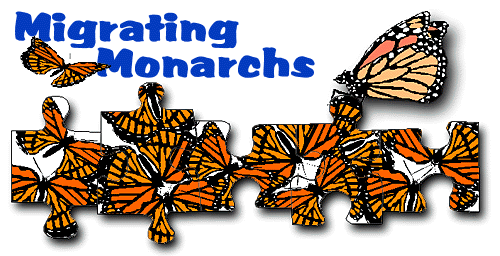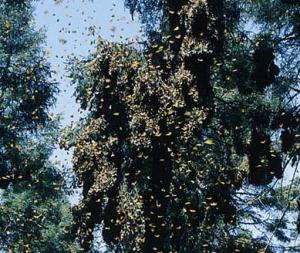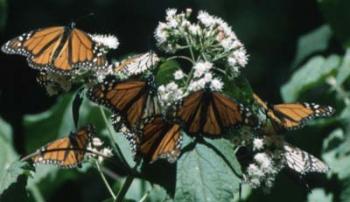
Illustrated by: Dr. Biology
show/hide words to know

Monarch butterflies overwintering in Mexico.
Monarch Butterfly Migration
Thousands of orange and black shapes flutter through the trees. They carpet the ground, making walking difficult. As you look up, so many of them hang from the trees that the branches bend under their weight. Welcome to one of the few wintering homes of the monarch butterfly.
During the summer, millions of monarchs live in southern Canada and the United States. In September, the adults prepare to migrate. They form huge flocks, just as some birds do. Moving between 10 and 15 miles a day, the flock eventually reaches its winter home in one or two months, depending on how far it has to fly.
Not all flocks winter in the same place. Butterflies that live west of the Rocky Mountains fly to the central coast of California. Butterflies that live east of the Rocky Mountains fly south to Mexico.
Although scientists knew about the California wintering grounds, they had no idea where the Mexican wintering grounds were. Fred Urquhart, a scientist at the University of Toronto, finally figured out where the butterflies were going. He glued tiny labels and instructions to return the labels onto the wings of monarchs. He was able to track the butterfly route using the labels that people returned to him. Eventually, he received labels from the wintering grounds.
Of course, the people in towns and villages near the wintering grounds knew that the butterflies were there all along. No one else had asked them before.

Monarch butterflies stop for a sip of nectar.
Monarch Butterfly Life Cycle
Because they migrate, monarchs complete different parts of their life cycle in different parts of North America. The monarchs that you see in any particular area are from several generations that hatched at different times in different places.
Male and female monarchs begin mating in their wintering grounds. The females lay up to 3 eggs on the underside of milkweed leaves that they find as they return to their summer range. The newly laid eggs hatch into hungry larva that eat and eat.
The plant foods that larvae and adults eat are very different. Monarch larvae only eat the leaves of plants in the milkweed family. Adult butterflies are much less choosy. They will sip nectar from many different kinds of flowers.
View Citation

Monarch Butterfly Danaus plexippus - Wikimedia
Be Part of
Ask A Biologist
By volunteering, or simply sending us feedback on the site. Scientists, teachers, writers, illustrators, and translators are all important to the program. If you are interested in helping with the website we have a Volunteers page to get the process started.









